This post was written by Peter Fuhr, PhD, Marissa Morales-Rodriguez, PhD, Sterling Rooke, PhD, and Penny Chen, PhD.
Factories, refineries, utilities (water/wastewater, electric), and related industrial sites are complex systems and structures with inspection and maintenance procedures required for optimal operation and regulatory compliance. For example, consider just the bulk electric power system, which comprises more than 200,000 miles of high-voltage transmission lines, thousands of generation plants, and millions of digital controls.
More than 1,800 entities own and operate portions of the grid system, with thousands more involved in the operation of distribution networks across North America. The interconnected and interdependent nature of the bulk power system requires a consistent and systematic application of risk mitigation across the entire grid system to be truly effective. Similar situations are found throughout the automation industry, which also frequently has aging infrastructure.
Consider, for example, the situation in a refinery or chemical processing setting with the requirement for leak detection inspection of pipes, interconnects, and systems across the plant. The current practices and challenges relating just to this task of detecting any fugitive emissions and documenting all measurements, and thereby meeting air compliance regulations, are typically "handled" by a small army of individuals with handheld or backpack-sized detectors.
They crawl through piping racks conducting measurements at each flange. Such work is performed in difficult conditions (in terms of temperature, humidity, and physical challenges) and frequently has a high level of employee turnover. Enter low-cost sensors and mobile platforms-in other words, unmanned aerial systems (UASs or drones) with enhanced sensing capabilities.
Drones: more than flying cameras
Remotely piloted aerial vehicles have been used, primarily by military forces, since the Second World War. With recent technological advancements in microprocessor computing power, sensor miniaturization, and purpose-built software, UAS technology has established a significant new niche in the evolution of aviation. Alternatively labeled unmanned aircraft systems, unmanned aerial vehicles, or simply drones, small UASs (sUASs) are becoming readily accessible for commercial, governmental, and private use across a myriad of far-ranging applications. (Note that the Oak Ridge National Laboratory's UAS Research Center recently released a best practices guide for UAS operation by electric utilities. See the sidebars for an overview of the rules for legal operation.)
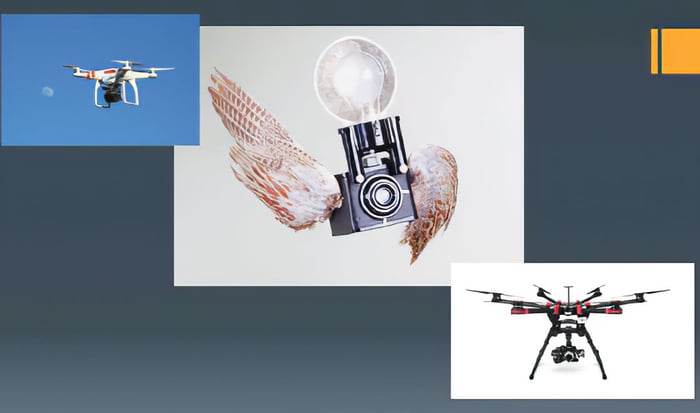 Figure 1. Some individuals view a drone as a camera with wings.
Figure 1. Some individuals view a drone as a camera with wings.
Although a "traditional" drone has a camera where video and still images may be stored on an onboard memory device or, in some instances, wirelessly transmitted to a handheld device, the operational situation changes when the drone's sensors can directly communicate with an industrial control or supervisory control and data acquisition (SCADA) system. Such a level of integration requires bidirectional communication transmission security, as well as logical protocol synchronization.
Such communications have been demonstrated using cellular telephony as well as licensed- and unlicensed-band wireless. With respect to the information presented in figure 2, the sensor-laden drones were controlled via approved Federal Aviation Administration (FAA) rules, but with the sensor "pods" communicating directly into the utility's core communication network via 900 MHz wireless and made available into the SCADA system (as opposed to using the same wireless channel for the drone control).
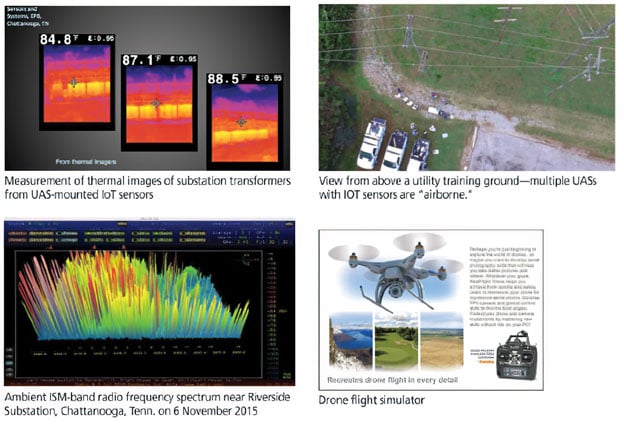 Figure 2. Multiple drones with sensors were used to measure a wide range of parameters at the EPB training site in Chattanooga, Tenn.
Figure 2. Multiple drones with sensors were used to measure a wide range of parameters at the EPB training site in Chattanooga, Tenn.
Multiple sensors within the "pod" measured parameters including temperature, humidity, atmospheric pressure, motion (via accelerometers), electric and magnetic field strength, coronal arc discharge, forward-look infrared (FLIR) thermal imagery, visual imagery, cell phone signals (Verizon, AT&T, T-Mobile, Sprint), and CH4 (methane).
Additional microcontrollers and specialized miniaturized network equipment were placed within the sensor pod, along with a separate battery-based power supply system tailored for the sensor package. A photo of the drone and sensor pod as it inspects an electrical distribution transformer is shown in figure 3. These proof-of-concept demonstrations-specifically showing airborne sensors providing real-time measurements of automation systems-are a glimpse into future applications.
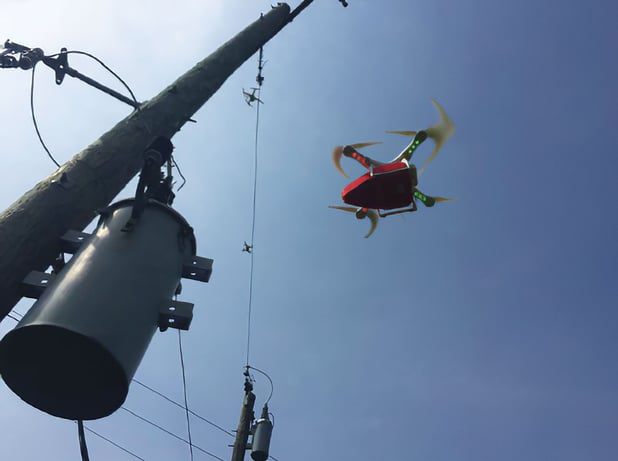 Figure 3. Sensor-laden drone inspecting an electrical distribution transformer
Figure 3. Sensor-laden drone inspecting an electrical distribution transformer
Being able to conduct three-dimensional assessments and inspections using a remotely operated sensor platform has led to a flood of potential uses of UASs-both envisioned and realized. UASs of all types have already been used in a wide variety of applications in practical ways, such as aerial photography, agriculture, commercial delivery, entertainment, exploration, national defense, public safety, surveying, and thermography. Envisioned future applications will help advance precision agriculture, energy-sector remote sensing, national security and law enforcement reconnaissance, and utilities analysis. Such "future applications" benefit from the remotely or autonomously controlled mobile platform bringing a wide range of sensors to a location of interest.
Operation and flight times
Weight versus power versus flight (operational) time presents the classic trade-off in a limited fuel-supply flight operation, be it aircraft, drones, or spacecraft. Empirical data has given way to estimators regarding the battery-operated lifetime for drone operation. Figure 4 presents the estimated range based on a wide array of parameters.
 Figure 4. The range that a drone can go (and return) for a variety of parameters.
Figure 4. The range that a drone can go (and return) for a variety of parameters.
Note that the figure 4 calculation incorporates overall drone weight, but specifically within the context of sensor-laden drones. It does not include the possibility of the sensor being directly powered off the same battery source as the drone itself. The working estimate for a battery-operated drone is a flight time of approximately 20 minutes. Note that there are wildly varying flight times for differing drone configurations-ranging from a few minutes to an hour. That said, the working rule of approximately 20 minutes for a standard consumer drone is accurate.
As battery technology (specifically energy density) improvements continue, the companion matter of battery-operated longer flight ranges or durations are anticipated. Given the FAA rules regarding drone operation and flight control, a set of questions arises that is typically associated with beyond-visual-line-of-sight (BVLOS) operation (and its implications on drone use in industrial settings) and flight times ("how long can the drone fly?") (see https://www.ecalc.ch/xcoptercalc.php?ecalc).
Again, the FAA rules are quite clear regarding BVLOS, beginning with the definition: "BVLOS means flight crew members (i.e., remote pilot in command [PIC], the person manipulating the controls, and visual observer [VO], if used) are not capable of seeing the aircraft with vision unaided by any device other than corrective lenses (spectacles and contact lenses)."
Although most current UAS applications are carried out in VLOS missions, there are obvious limits to VLOS inspections. With respect to BVLOS operation for electric utilities, BVLOS allows personnel to monitor power lines over longer corridor stretches. Via the FAA Extension, Safety, and Security Act of 2016, Congress authorized the FAA to develop new rules specifically to benefit the electric power industry and other operators of critical infrastructure. Under this new legislation, the FAA will begin to develop rules enabling BVLOS flights and night flights.
Other changes are expected to streamline the permitting of UAS flights and improve commercial viability and safety while facilitating inspection of critical infrastructure. Any new rules are not expected to become part of formal regulations until 2018 or beyond. However, many operators under Part 107 are expected to apply for waivers to a number of Part 107 regulations, such as flying at BVLOS distances. Some of these waivers are likely to be granted in advance of more formal regulation changes that will arise from the 2016 act. On 28 December 2016, the FAA approved a certificate of authorization for the Northern Plains UAS Test Site in North Dakota to be the first in the U.S. to have BVLOS operability. Other locations within the U.S. now have similar exemptions to the BVLOS rule.
Coordinated flight and collaborative sensing
Advancements in control systems for UAS flight dynamics operating on inexpensive, lightweight (power and computational requiring) microcontrollers with networked wireless communications have led to instances where multiple drones fly in formation. Such coordinated flight was demonstrated during the 2017 Super Bowl halftime show and at several amusement parks worldwide. In an automation setting, the coordinated flight of multiple drones, each equipped with a variety of sensors, leads to collaborative sensing of mobile sensors.
Examples of where such "coordinated flight - collaborative sensing" (CFCS) applications exist include the possibilities of sensing chemicals-such as CH4-and environmental and ambient conditions associated with storage tanks at fracking sites (figure 5), bridge inspection, and power generation facilities (examining pipes for cracks from rapid thermal cycling of coal-fired plants due to wind generation variability).
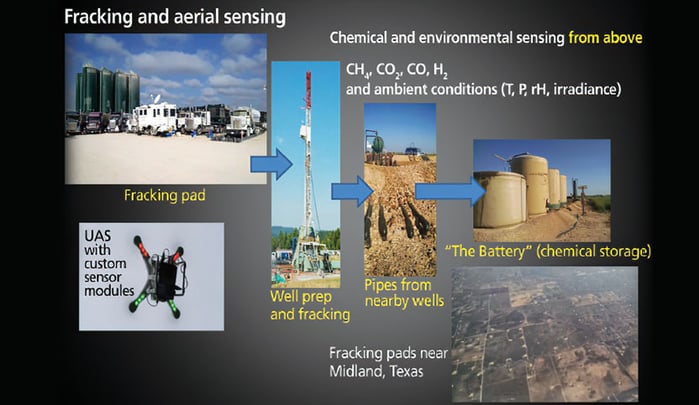 Figure 5. A drone as a mobile sensor platform allows for measurements to occur in variety of situations, such as those associated with fracking.
Figure 5. A drone as a mobile sensor platform allows for measurements to occur in variety of situations, such as those associated with fracking.
UAS traffic management systems are critically important for the drone industry. These systems help keep control of flying drones, and between unmanned and manned traffic. Developments within academia, national laboratories (i.e., Department of Energy and National Aeronautical and Space Administration), and the private sector are underway for reasonable and deployable UAS detection systems.
Using drone-based sensing
It is not just drone-based sensing, but rather how to use the measurements made via such platforms that is significant. The following statements from Thomas Haun, vice president of strategy and globalization at PrecisionHawk UAV Technology, are applicable throughout the application areas where drone-based sensors may be used:
"Commercial drones are flying in. The industry needs to see beyond the UAV and focus on the real disruptor: actionable analytics via aerial data. As we prepare for widespread adoption and integration across major markets, such as agriculture, oil and gas, insurance, infrastructure, emergency response, and life sciences, businesses need an intelligent solution that combines UAV hardware and automated data analysis software to deliver tangible results at scale."
The intersection of the Industrial Internet of Things (IIoT), cyber-physical security, and sensor-laden drones presents an array of opportunities for use in automation. Standards and guidelines can help carve an orderly path forward. This path will allow industry to incorporate advanced technologies into procedures and practices as this booming market sector introduces devices and systems. It is envisioned that in the very near future drones of varying sizes and complexities-equipped with sensors-will be operated from a remotely located control center with real-time measurements intermixed with sensor data from other fixed and mobile platforms. It will monitor and record within an industrial control or SCADA system, such as that shown in figure 6.
ISA's Test & Measurement Division and Communication Division currently have a joint working group focused on IIoT, cyber-physical security, and unmanned aerial systems with the associated examination of functional and operational security for when these devices are deployed into a control system. Additional information on these and related topics-including videos of the operation of sensor-laden drones-are available on each division's website.
Let's risk the machines, not the humans.
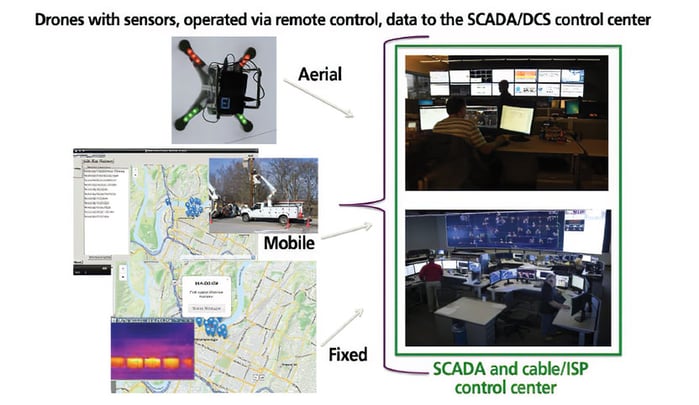 Figure 6. Integration of fixed and mobile sensors, UAS- and truck-mounted, with command, control, and real-time data coordinated at the center.
Figure 6. Integration of fixed and mobile sensors, UAS- and truck-mounted, with command, control, and real-time data coordinated at the center.
New FAA rules
The FAA's comprehensive new regulations for the routine, nonrecreational use of sUASs-more popularly known as drones-went into effect 29 August 2016. The provisions of the new rule, known as Part 107 or Rule 107 (14 CFR Part 107), are designed to minimize risks to other aircraft and to people and property on the ground.
The FAA has put several processes in place to help you take advantage of the rule:
Waivers: If your proposed operation does not completely comply with Part 107 regulations, you need to apply for a waiver of some of the restrictions. You must prove the proposed flight will be conducted safely under a waiver. Users must apply for these waivers at the online portal www.faa.gov/uas.
Airspace authorization: You can fly your drone in Class G (uncontrolled) airspace without air traffic control authorization, but operations in any other airspace (i.e., instrument flight rules) need air traffic approval. You must request access to controlled airspace via the electronic portal at www.faa.gov/uas, not from the individual air traffic facilities.
Summary of 14 CFR Part 107 (FAA rule/Part 107)
The FAA Part 107 regulations, which legalize commercial drone use, dramatically increase the potential number of UAS users. Anyone can now legally operate a UAS as part of a business after first passing an aeronautical knowledge test and then registering with the FAA. In the first two days after the test became available, 1,338 people had completed the test with an 88 percent pass rate.
Small unmanned aerial system operational limitations
The following restrictions and limitations are based on "Operation and Certification of Small Unmanned Aircraft Systems: Final Rule" as published in the Federal Register, volume 81(124), 28 June 2016, pp. 42063-42214 (FAA, 2016).
- sUASs must weigh less than 55 pounds (25 kg).
- sUASs must remain within visual line of sight of the remote pilot in command and the person manipulating the flight controls of the sUASs. Alternatively, the sUAS must remain within VLOS of the visual observer.
- sUASs may not operate over any persons not directly participating in the operation, under a covered structure, or inside a covered stationary vehicle.
- sUASs are limited to daylight-only operations, or civil twilight (30 minutes before official sunrise to 30 minutes after official sunset, local time) with appropriate anticollision lighting.
- sUASs must yield right of way to other aircraft.
- First-person view cameras cannot satisfy "see-and-avoid" requirements, but can be used as long as requirements are satisfied in other ways.
- sUASs are limited to a maximum ground speed of 100 mph (87 knots) and a maximum altitude of 400 ft above ground level (AGL) or, if higher than 400 ft AGL, remain within a 400-ft radius of a structure. They must fly no higher than 400 ft above a structure's uppermost limit.
- External load operations are allowed if the object being carried by the UAS is securely attached and does not adversely affect the flight characteristics or controllability of the aircraft.
- Transportation of property for compensation or hire is allowed if:
- the aircraft, including its attached systems, payload, and cargo weigh less than 55 pounds, total
- the flight is conducted within VLOS and not from a moving vehicle or aircraft
- the flight occurs wholly within the bounds of a state and does not involve transport between (1) Hawaii and another place in Hawaii through airspace outside Hawaii; (2) the District of Columbia and another place in the District of Columbia; or (3) a territory or possession of the U.S. and another place in the same territory or possession
Most of the restrictions enumerated above are waivable if the applicant demonstrates that his or her operation can safely be conducted under the terms of a certificate of waiver.
About the Author
Peter Fuhr, PhD, is a distinguished scientist at Oak Ridge National Laboratory and also serves as the technology director for the Unmanned Aerial Systems (UAS) Research Laboratory. He is the director of the ISA Test & Measurement Division.
About the Author
Marissa Morales-Rodriguez, PhD, is a research and development scientist at Oak Ridge National Laboratory. She has been working in the area of chemical sciences, concentrating on applications related to sensing, additive manufacturing, and document security. She is director-elect of the ISA Test & Measurement Division.
About the Author
Sterling Rooke, PhD, is the founder of X8 LLC, a technology company focused on industrial sensors with an eye toward cyber- and energy security. On a part-time basis, Rooke is the director of training within a Cyber Operations Squadron in the U.S. Air Force. In his role as a reserve military officer, Rooke leads airman through training exercises to prepare for future conflicts in cyberspace. He is the director-elect of the ISA Communication Division.
About the Author
Penny Chen, PhD, is a senior principal technology strategist at Yokogawa US Technology Center (USTC), responsible for technology strategy and standardization focusing on wireless, networking, and related security, and exploring new technologies for industrial applications. Chen is actively involved in ISA100, Wireless Systems for Automation, and a variety of IoT standardization activities, including IEEE P2413 IoT Architecture Reference Framework. Chen received a PhD in electrical engineering from Northwestern University. She is the director of the ISA Communications Division.
A version of this article also was published at InTech magazine.



